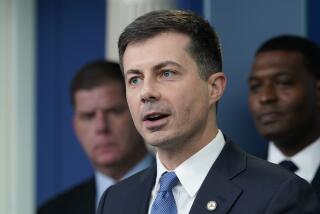Senator Raps Secy. Dole’s ‘Double Talk’
- Share via
WASHINGTON — A senator told the secretary of transportation today to stop using “double talk and petty technicalities” and take serious steps to improve air safety and reduce airline delays.
But Transportation Secretary Elizabeth Hanford Dole, testifying before the Senate Appropriations Committee’s transportation subcommittee, said her agency has been straightforward about its safety program and has adjusted its efforts wisely during a period of rapid air traffic growth.
The exchange between Dole and Sen. Frank R. Lautenberg (D-N.J.), chairman of the subcommittee, was the latest in a series of skirmishes between Congress and the Transportation Department over safety in the nation’s skies.
Rebuff Remembered
Many lawmakers have been resentful since the department’s June 4 request to Congress to increase the number of air traffic controllers and supervisors by 955 by Sept. 30, 1988, the end of the 1988 fiscal year. Before that request, legislators had repeatedly urged the Federal Aviation Administration--a branch of the Transportation Department--to hire more controllers, only to be told they were not needed.
In addition, the FAA rejected a call in May by Jim Burnett, chief of the National Transportation Safety Board, to ease air traffic in the nation’s busiest regions, only to reverse itself in June and adopt steps to reduce the congestion.
“For too long now, we have been subjected to a deliberate and persistent campaign of double talk and petty technicalities on some vitally important issues,” Lautenberg told Dole. “We are tired of these word games and we hope they stop.”
Increase Underestimated
Dole told Lautenberg that the department decided it needed more controllers after a three-month study revealed that air traffic would increase by 5% to 6% in 1988, not the 3% to 4% previously estimated.
“I don’t want you to be surprised if we come back with another assessment,” she said. “We’re looking at traffic down the road. This is a dynamic situation.”
But Lautenberg said he had no faith in the department’s ability to project its need for air traffic controllers.
“I don’t know that this is enough, and frankly, from what I’ve been seeing, I don’t know that you know that this is enough,” he said.
The additional air traffic controllers would bring their number to 15,805. There were 16,375 controllers before their 1981 strike, in which President Reagan fired 11,345 of them for refusing to return to work.
More to Read
Sign up for Essential California
The most important California stories and recommendations in your inbox every morning.
You may occasionally receive promotional content from the Los Angeles Times.










